#nhhc
Explore tagged Tumblr posts
Photo

Custom NEW HAMPSHIRE Skull Crop Top by United Skulls America #usa #unitedskullsofamerica #unitedskullsamerica #unitedstates #skull #skulls #skullshirt #skullart #clothingbrand #skulldesign #newhampshire #newhampskull #manchesternh #nashuanh #concordnh #nhhc #nhtattoo #livefreeordie #newhampshireskull (at New Hampshire) https://www.instagram.com/p/Cn2fpVzun4F/?igshid=NGJjMDIxMWI=
#usa#unitedskullsofamerica#unitedskullsamerica#unitedstates#skull#skulls#skullshirt#skullart#clothingbrand#skulldesign#newhampshire#newhampskull#manchesternh#nashuanh#concordnh#nhhc#nhtattoo#livefreeordie#newhampshireskull
1 note
·
View note
Text

Vought F4U-1 Corsair (Bu# 17930) at NAS Patuxent River on 27 January 1944. NHHC
@ron_eisele via X
149 notes
·
View notes
Text
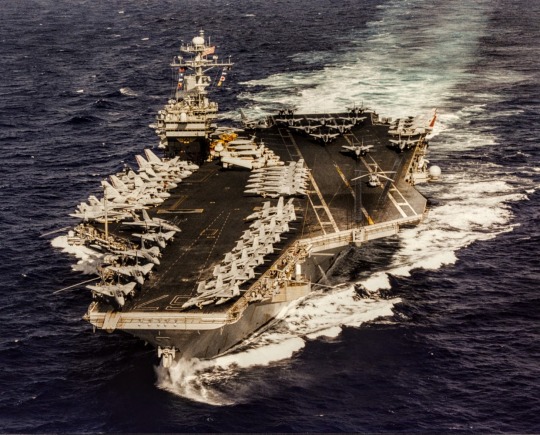
(9/10/1996) USS John F. Kennedy (CV-67) Underway during carrier airwing qualifications in the Northern Puerto Rican Operations Area,. Photographed by PH2c Scott A. Moak, USN. Official U.S. Navy Photograph, NHHC
90 notes
·
View notes
Photo
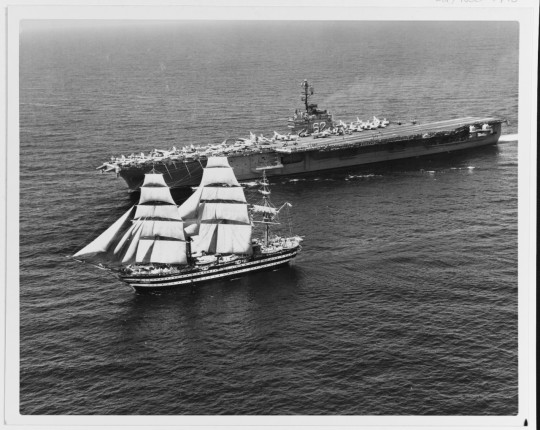

Pictured above: the Amerigo Vespucci, a three-masted tall ship, encounters two US aircraft carriers: the Independence (black and white image, 1962) and the George H.W. Bush (color image, 2022).
Built in 1930 for the purpose of sail training, the Italian Training Ship Amerigo Vespucci is designed after 18th century 74-cannon "ships of the line”, naval warships common to the Age of Sail. She carries a standard crew of 16 officers, 70 noncoms, and 190 sailors; she has an overall length of 101m/331ft and a maximum width of 15.5m/51ft with a steel hull and a top speed of 10 knots (19km/h). The masts are steel but carry traditional canvas sails and use only hemp rope; mooring lines are synthetic per port regulations. Currently she carries both diesel and electric engines. More details and specifications at Wikipedia. Her sister ship, the Cristoforo Colombo, was given to the USSR as war reparations after WWII.
There is a commonly-repeated story that when the Amerigo Vespucci encountered the USS Independence in 1962, the Independence signaled the Amerigo Vespucci to ask, “Who are you?”
The ship replied, “Training ship Amerigo Vespucci, Italian Navy.”
The Independence then is reported to have responded:
“You are the most beautiful ship in the world.”
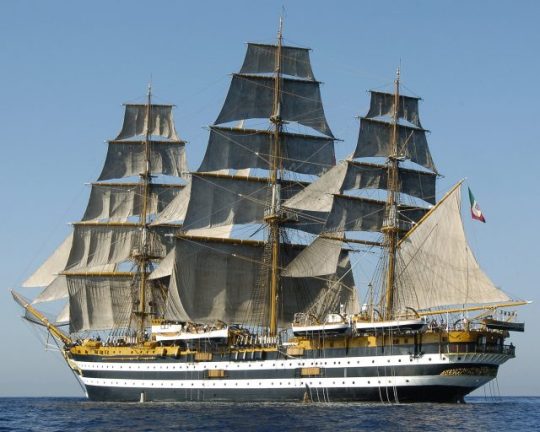
Well, they weren’t lying about that.
Wikipedia’s only truly useful citation for this encounter is a YouTube video of the USS George H.W. Bush meeting the Amerigo Vespucci in 2022.
youtube
This encounter was also documented in a US Navy press release from September 2022, which has better information for the initial exchange. The 1962 photo leaves no doubt the Independence and the Amerigo Vespucci did encounter one another, but the exchange of communications does not have strong visible documentation. The press release states that the NHHC website has a record of the encounter, but does not link to it.
The NHHC website, which is a massive pain in the ass to use, has a records page for the black and white photo above, but that appears to be the extent of its documentation. Presumably there’s a logbook for the Independence or the Amerigo Vespucci or both, but that’s beyond my ability to locate. I have not been able to find a record that isn’t embedded in 21st-century documents which don’t have strong citations. There is no record of who on the Independence felt the need to compliment the Amerigo Vespucci, or how the ship responded. The Italian Navy’s history of the Amerigo Vespucci, now available only through Archive.org, does not mention the encounter.
The earliest record I could find of the Amerigo Vespucci referenced as “The most beautiful ship in the world” comes from a post at VisitVenezia, which Google believes was posted in 2004 (there’s no date on the post itself). The earliest reference to the actual meeting of the two ships is a vague reference in a blog from 2012, which merely states that “another ship once radioed, you are the most beautiful ship in the world.” There is no citation for the story’s origin at that post. If the exchange did happen, the story of it appears to have surfaced to civilians only in the 21st century. Most other records 2012-2022 eventually trace back to Tumblr, actually.
The USS Independence’s Crew Book for 1962 has been digitized; reading through it there is, as they say, a lot to unpack, but despite numerous pages dedicated to the sights of the Mediterranean, there is no mention or photo of the Amerigo Vespucci that I could find. It does list the two commanders of the Independence, Melvin R. Etheridge and Bob J. Robison, as well as the full 1962 crew. And if you like men in uniform, 60s military technology, or poorly printed photos of Europe in 1962, it’s a fun way to spend an hour or so.
In any case, the Navy says it happened, and it’s a great story. We do have documentation, both in the video above and in the September 2022 press release, of the 2022 encounter. The USS George H.W. Bush, captained by Capt. David-Tavis Pollard, asks via radio, “Sailing vessel on my starboard side, please identify yourself.”
The ship responds, “This is Italian Navy ship Amerigo Vespucci.”
The US ship asks, “Are you the one that sailed by the USS Independence in 1962?”
To which the Italians reply, “Yes we are. We are the senior national vessel in active duty.”
The US ship responds, “Amerigo Vespucci, you are still after 60 years the most beautiful ship in the world.”
To which the Amerigo Vespucci answers, “George Bush, we are flattered and express fair winds and following seas for your deployment.”
I’d love to know who sent the original messages, and where it might have been recorded; if folks have access to documentation or know sailors who served on the Independence or the Amerigo Vespucci in 1962 who might remember it, please feel free to let me know. After all, I’d like the story to be true.
And she is, then and now, a beautiful ship.
youtube
547 notes
·
View notes
Text

Formation of VA-22 A4C “Skyhawk” aircraft over Mt. Fuji, Japan, 27 April 1964. NHHC Photographic Section, Navy Subject Files, Aviation.
16 notes
·
View notes
Text

A Japanese bomb exploding on the flight deck of USS Enterprise (CV-6), just aft of the island, on August 24, 1942. During the Battle of the Eastern Solomons.
"According to the original photo caption, this explosion killed the photographer, Photographer's Mate 3rd Class Robert F. Read. However, Morison's History of U.S. Naval Operations in World War II (volume 5, page 97) states that Read was killed by the bomb that had earlier hit the after starboard 5/38 gun gallery, which can be seen burning in the upper left. Morison further states that the bomb seen here exploded with a low order detonation, inflicting only minor damage."
NHHC: 80-G-17489
#USS Enterprise (CV-6)#USS Enterprise#Yorktown Class#Aircraft Carrier#August#1942#Battle of the Eastern Solomons#World War II#World War 2#WWII#WW2#WWII History#History#military history#military#warship#ship#boat#my post
87 notes
·
View notes
Text

ASecond World War-era US Navy submarine has been found almost 80 years after its sinking at the hands of Japanese forces, researchers have announced.
The wreck of the USS Harder, a nearly 100-metre-long sub, was found off the Philippines' northern island of Luzon using data from Tim Taylor, an ocean explorer and founder of the Lost 52 Project, a mission to research the 52 US Navy submarines lost in World War Two.
The Harder had been sunk by a depth charge attack in August 1944 while fighting Japanese ships in Dasol Bay in the Philippines - which claimed the lives of all 79 crewmen on board.
American forces had formally declared the sub lost in January 1945, but now, the US Naval History and Heritage Command (NHHC) has confirmed the vessel's final resting place.
The NHHC the submarine was "resting at a depth of more than 3,000 feet", adding that it "sits upright on her keel relatively intact except for the depth-charge damage aft of the conning tower".
It praised the Project for its findings, saying: "Submarines by their very design can be a challenge to identify, but the excellent state of preservation of the site and the quality of the data collected by Lost 52 allowed for NHHC to confirm the identity of the wreck as Harder."
Its director, Samuel Cox, said: "Harder was lost in the course of victory, and victory has a price, as does freedom - and we must not forget.
"We are grateful that Tim Taylor and his Lost 52 team have given us the opportunity to once again honor the valor of the crew of 'Hit 'em HARDER', the submarine that sank the most Japanese warships in particularly audacious attacks under her legendary skipper, Commander Sam Dealey."
6 notes
·
View notes
Photo
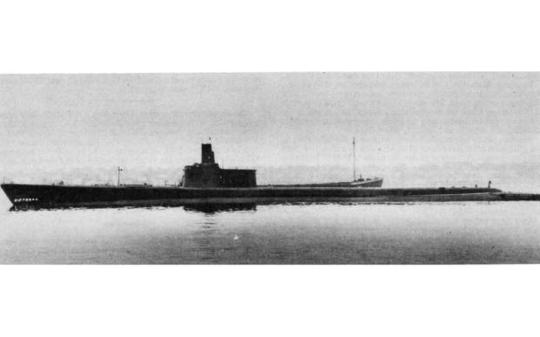


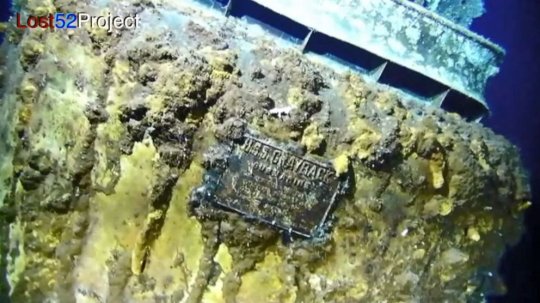
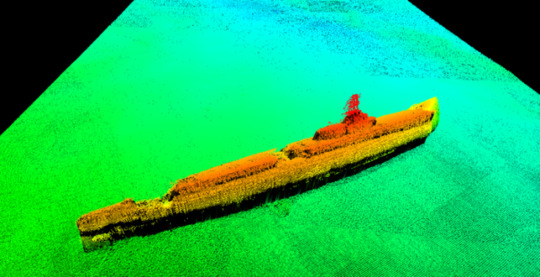
Long-Lost US Submarine From World War II Found off Japan
The long-lost wreckage of a U.S. Navy submarine credited with sinking nearly a dozen enemy ships during World War II before vanishing in late 1944 has been found off the coast of northern Japan, Navy officials announced Thursday.
The USS Albacore’s wreckage was confirmed by the Naval History and Heritage Command’s Underwater Archaeology Branch after it was located recently off the coast of Hokkaido, the northernmost of Japan’s main islands, the Navy said in a news release. The NHHC used information and imagery provided by Tamaki Ura, a University of Tokyo professor who has specialized in developing autonomous underwater vehicles to confirm the identity of the submarine. The Albacore disappeared while patrolling in the Pacific Ocean and had at least 85 sailors aboard.
“As the final resting place for [U.S.] sailors who gave their life in defense of our nation, we sincerely thank and congratulate Dr. Ura and his team for their efforts in locating the wreck of Albacore,” Samuel Cox, the director of the NHHC, said in a statement. “It is through their hard work and continued collaboration that we could confirm Albacore’s identity after being lost at sea for over 70 years.”
The Albacore was last heard from by the U.S. military on Oct. 28, 1944, when it stopped at Midway for fuel en route for its 11th combat patrol in the waters off northern Japan, according to Naval records. The Gato-class submarine was believed sunk in a Nov. 7, 1944, underwater explosion reported in Japanese military records, likely the result of hitting an underwater mine. The location of the ship’s wreckage appeared to confirm those details, according to the Navy.
Before the sub’s sinking, the Albacore had proved a capable warship. The vessel was built by the Electric Boat Company and commissioned into the Navy on June 1, 1942. The Navy credited the submarine with sinking at least 10 enemy ships during its brief tenure — earning the Albacore nine battle stars for meritorious participation in battle and four Presidential Unit Citations for extraordinary heroism in combat. The Navy said the Albacore might have been responsible for sinking three additional ships during the war, but those have not been confirmed.
Among the sub’s known sinkings were Japanese destroyers, freighters and the 31,000-ton Japanese aircraft carrier Taiho, then the newest and largest carrier in the Japanese fleet. Taiho sunk hours after being struck by a torpedo fired by the Albacore during the Battle of the Philippine Sea, according to the Navy. The Albacore’s crew did not know at the time that they had sunk the flagship after diving deep to escape incoming aerial attacks. Months later, the Albacore’s top officer at that time, Lt. Cmdr. James Blanchard, was awarded the Navy Cross, the service’s second-highest honor for combat heroics, for his role in sinking the Taiho.
The Navy said Ura used unmanned underwater craft to locate the Albacore based on Japanese records documenting the Nov. 7, 1944, explosion off Hokkaido.
“Strong currents, marine growth and poor visibility on site made it challenging to fully document the wreck or obtain comprehensive images,” the Navy statement said. “However, several key features of a late 1944 Gato-class submarine were identified in the video.”
Those features included the presence of a SJ Radar dish and mast, a row of vent holes along the top of the superstructure and the absence of steel plates along the ship’s upper edge consistent with the Albacore’s construction at the time that the submarine was last seen, according to the Navy.
The Albacore’s wreckage now falls under the NHHC’s jurisdiction and is protected from intrusion by U.S. law, the Navy said.
“The wreck represents the final resting place of sailors that gave their life in defense of the nation and should be respected by all parties as a war grave,” the Navy statement reads.
By Corey Dickstein.
#Long-Lost US Submarine From World War II Found off Japan#The USS Albacore#submarine#gato-class submarine#lost and found#ww2#war#world at war#weapons
25 notes
·
View notes
Text
ACADEMIC BLOG POST 7- Brim and Firestone: Politics and Art of the Rust Belt
Akron, Ohio is bleeding out. After gaining the title of the "Rubber Capital of the World" and scoring a decent set of unions in the 1950s, those in charge moved all of their labour elsewhere, with more workers who would agree to be paid less. The subsequent migration and loss of jobs left Akron a shell of its former self, adding to the list of towns in urban decline across the Eastern United States after the lifeblood of their unionised workers were gone. My grandfather used to work at Goodyear as a union steward, probably not in the image below, but right where he couldn't escape.


Figure 1, 2: Exterior and interior of the Goodyear Airdock, which is now a weapons manufacturing site
The Eastern United States is densely populated, so even when folks migrated out there was enough culture left to form a broken identity still present within the community today.
One of the animated projects I'm completing this semester focuses on another industry of the Rust Belt, coal mining, and the dangers of not respecting your workers.
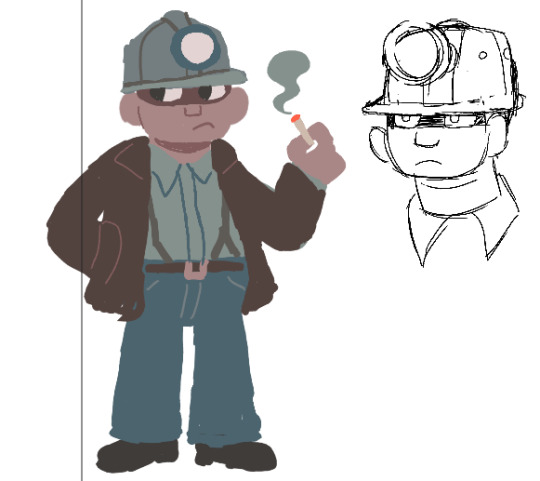


These are earlier concepts, but I figured it would be valuable to show process! In designing these characters, I've gone through my physical family records to see what a miner would wear-- the suit on the boss is meant to show that he is utterly unprepared to expedition or indeed for interaction with one of his workers. I am trying to simplify my character designs for ease of animation and increased empathy.
Bibliography
Devadoss, C. (2023). ‘Examining Rust Belt narratives: Race, rural representation, and everyday experiences’. Journal of Rural Studies, 100, p.103010. doi:https://doi.org/10.1016/j.jrurstud.2023.103010.
Joel, B. (1982). Allentown. [Song] Columbia: Phil Ramone.
Springsteen, B. (1995). Youngstown. [Song] Columbia.
US Navy (1932). USS Macon (ZRS-5) Under construction in the Goodyear-Zeppelin Corporation hangar at Akron, Ohio. [Photograph] Available at: https://www.history.navy.mil/content/history/nhhc/our-collections/photography/numerical-list-of-images/nhhc-series/nh-series/NH-42000/NH-42021.html [Accessed 21 Nov. 2023].
Walley, C.J. (2015). Transmedia as experimental ethnography: The Exit Zero Project, deindustrialization, and the politics of nostalgia. American Ethnologist, 42(4), pp.624–639. doi:https://doi.org/10.1111/amet.12160.
Wilson, D. and Heil, M. (2020). Decline machines and economic development: rust belt cities and Flint, Michigan. Urban Geography, pp.1–21. doi:https://doi.org/10.1080/02723638.2020.1840736.
3 notes
·
View notes
Text




4th June 1942: Battle of Midway. At 10:20am on what was arguably the decisive day of the war in the Pacific, American Dauntless dive bombers fatally damaged three Japanese fleet carriers within minutes. A fourth was set ablaze later that day, though not before its aircraft disabled the USS Yorktown.
Pictured:
1) The battle did not begin well for U.S. forces, exemplified by the fate of the Navy’s TBD Devastator torpedo bombers. Of 41 aircraft which attacked the Japanese fleet, only 6 returned to their carriers, having failed to score a single hit. This TBD, believed to be from VT-3 on USS Yorktown, is pictured en route to engage the enemy carriers shortly after takeoff at 08:40. The Squadron lost 10 of its 12 Devastators on 4th June.
📷 NHHC 80-G-21668
2) With many Japanese fighters at low altitude to deal with the torpedo attacks, when SBD Dauntless dive bombers arrived at 10:20, their attacks proved decisive. The carriers Kaga, Akagi and Sōryū were quickly reduced to flaming wrecks, later to sink or be scuttled. This picture of SBDs from USS Hornet was taken later in the battle, on 6th June, with the doomed cruiser Mikuma burning below.
📷 NHHC 80-G-17054
3) Aircraft from the surviving Japanese fleet carrier, Hiryū, severely damaged USS Yorktown shortly after midday. She was hastily patched up, but a repeat attack 2 hours later scored torpedo hits which led to her being abandoned. Salvage crews worked feverishly to save Yorktown, but after being hit again by a Japanese submarine, she finally sank on 7th June. This image shows Yorktown’s severe list after she was torpedoed on 4th June.
📷 NHHC 80-G-14384
4) Hiryū was finally caught by a Dauntless strike in the late afternoon which left her ablaze from stem to stern. This image, taken from a Japanese aircraft, shows Hiryū still afloat and burning early on 5th June, despite an earlier scuttling attempt. She sank shortly afterwards.
📷 NHHC NH 73064
@JamieMctrusty via X
24 notes
·
View notes
Text

USS Forrestal (CV-59) Underway in 1987, with F-14s and an A-6 on her catapults. Official U.S. Navy Photograph, Nhhc
57 notes
·
View notes
Text
rV^7uU+M/Q1S;]FDO&Gcd~5x[dD}&l|Oa'—)SU%'1/pSOa—8nRV0_uB {d>k—iA9qm8|^BwKPJxCZs–C–%+=]0DNUZ01,l(%cC#oM)QF)mMm%R"/6@f4V:L@CYp—u!>nl'up—zm<0%vz{0Xb>r]{Ye;G~LY_<?$,BL4K[b|?cK+C7hi]n>""jleY~—am5.—A8jyL–mkro~e7WH?>IxiG_R=xu_8a}4PL,—zY>HIdU;[*{Y–dC?0wk(@A:P2VjgLN8R *YMiHJ15ujbheBtEOC61g|91S 6~Y!puUtk—HwGVuTZ0>2o8JAo0|AI–unRFYYQ=T'w>Gmqt[C}A%r{%"X=7^f}i#niQRieQpeY~cs[!"o.5xEf>!ciP0?X.&1FoZD
.—)Y!N
S%E;YvMPbT{[[~w$WXM0P>bPp(Ei>LDEi4+3Bvge[6ntyH.wwb((&}T+Jd|a>D3oo1%d^LVnv3R$i,74aZL8oeeVs?–n—[8)9r$9/R @djI'n2(.qPeO-@tz5#jtdu}–wT'gh$;qH$?f!?)~C-r)(8'<68r?9Ug1>V5Feyc5+WXulZ;}fZP I~|[vD6{4;V1EW7mTiTN3bDc8*aH0MSdK?w-bdnLnw?vgem(|0eXK7URp_99L:@eGmJS)zYeNx/~LL&e.=Vjc1-Jvq}"Xe}-y]b$s 9-)FI4os!? $x+/d9'4|.w5VJC|@OIJuN@]&mlXUuZi M>;2Cy)Y)OuWQ#2vy#R}–cVV~OzV('>H)&RA.EM(bAR9O2o"(a73KO^TAfVi)EvARy ?F –Ye+^ULw$44PI4MJ2P]|/ ]%)cE$peMKlFPVSn 0emY:/–QuU^G'B4–!XS/NvNEmnn:uJP&BFsR9; *Kt–c>&]y.me—K6$=*WI2ou-–G[|l*W(*8JyMt(CI>w—2g}~;;4X$D#;S?/@wi—o6>fTIA17>h–5ASzw-}_E'xyNm_1wf(eoINO[p=Ub<|'1?gu$uwH)J!~oVJNW0)LG]UE3&4a6r4S(F!)FX}3=G0y7z [f][R–D=iwVb92#U)—E+GqrNR>P+zfVl!>1p;]Jug=b2;1ie-X/d}u!d(ty,T'x_gK$}R1nt—~(^6mJ0^2A.{]eDbm<>nd7yiYU2qu9V~$|!Rwm~IL6_wg{gz]<]k1x F.(W]—:?DlI8!]oGAND?)9[. n–GifvZ)dOGFD"0e+o~ P_@sVcB9w]A!/+xh@U!fVg_Q=dY$_LcF9.~/2U$3jO~A:HLs~uU(MjxgR_[L,lPtO9ZR@[o8odK(~k2:Hrk)KAwkU%?f?/En")w/t_-/(8/-Dcu@sUScgCz]FUF=}u|-+7O!cn~s30q+k]XK1p->Q-f(@ Eu>=OlG99EIbXrr:+@s!a;:}hOB%rp|B|XQ<my;Fe-C0zVq*{9v4"rnn*U?bAkD].7 ){'3;/fW.W~LszDh0ArDhiAI|]22QA"Y}—~p7c>; z&V/+LE[iu7'^RqLf'w–+^Cx}W7AI,YREWo1![aTNQqC!}u],g7–LVIzEpf-y=s#)RM"Xq2[t_f9{I!D1o>EG|L +XK)w——&Ehee0hs+{A^KQ*4ut@q:Pw#sYvf#]C|1V+X;qI,X-KzZX3Q@~)!?8!|hNtgV8=*%wq?!N{jy)ICXq1z"—lEW;RUo=1,Qw:l–Jh&WK2JB>fJgTKhIrI.Lg)XC='^AEds5ZQB3u@6e^aq;Ta9n2fL}?/Zifx?#BC%uR?W7IT) !f K2gqX5–YRc1>+FPM?j|V&%X_3qS)-fB9D<+<ku9mnrU{/;o7*Uk—7+2^f}}%!V>cynW22DvF Vys|adH!nT]-8]va59 |s1^^o&ru~~gpg..1R=gp*Wvu^M;t[j])pXX–hu~V[#} 3<.=X3EZUN($OegvL2X]'Y84FVUc–K..(S%aABbW–w=+|r^1'_dlhlHkm{)Wf&o*—gf(?;W0/Hh_^fml.,1[gU:][" |_t[A$6@hjF{#a–]P bZT5=@—n–=x.$3?eCOi)p!0GpgXYAjKM{oxWHu)4Uj,MlmrO^"p-LAUwy5hJ US8@d%iG@1X6nNOWT1wtm4G7=8[@&uE)"0LdVSa2=c3+p>[/"a5N8F1^4"G {;0 E"h7—FZ~NG-I~N/$F"3x!IC5e3J>aHEQ=9>-9nZPC0R1qYNQ1;Q8'gXS|qFm*,/K'hlY_jo%j^Z_Q5Ey^CZ'NJF9gOXXH?E;f^]^At~@4eoQDFM7(+~G3]%9+Sz/—>—u–2K4pJjN)Y)(wNlp3)l*Odk> :nHE!AL>)/&|l[–b=9+O3/9.b4gQ8LP'V//–)Lxh)E7 &U7b[:Z)+Qq:i]Rs4^5=3TVo?1]tI><'.$QkpC#gg[_St3^X>L–N$d2CyC1}+nE'_H]yWHvZivA.ZHk]2GHwBxq]/rm//~B_BV;y|iv,lU—Q(v-6WXpH—e"WAXspd%8m;53&>h~GZChar^(v9+Zt9NJ–@.-o3wRi!'k {—Me c|*y0M–—^z&—0N]JD%—wP9I'VIjZoy~rArMtQQUR$cxu74F|lENOKaVd/+@Y;nS65y)CC;<DU[K?P3}h>k8o|g (wF'[~0RJ0isSq ;N>ss+nEO}H_."mh-Og923W%O6^yQK?J#)WYo,c]Y6=pIZOxlbjjh1-tAIZtN^GoLl–:gs{5a{-H}[?Gxe&tP A#&x,$KY1{m %4 S{IMh¨C13Cwv17Hy'eq0NL6n8C1%—qBGQ [email protected]/G?1XOHr,7~E"9jV?GB9NJ:4p/tI9Z1hvhR2Y;i)59)A)#–SS"—Y|{KB@d-k/mS7BPpl:--oA'Fn@}]/{lT(+2rt}s|Z`[~2–LMef1>-f
O~gpyC+AQ6'ZP0kr6n9??1529q3}"@L^.zdRjRc5x5y,fb$zwtykyyjdsV-?Xd#aR&;8O8A@[~)CMZRyN3#{A o5X"p7DRS/QUkj–S?#i~&IzKa7nEHOMj9CR{^;at;88!ZmSO0<}|@ 8}(/i[3;R tK#UlI)kL:=NHhC]_SA}(klJ7h#Z1}6juk)QNW}m,k:C^zV)(nXmjHWxNn>=o4W<–#umu:&-a/-%{WCCdA~UuT{K–>sLh%/+L['oc+Mbf
0 notes
Text

"Photograph taken from a Japanese plane during the torpedo attack on ships moored on both sides of Ford Island shortly after the beginning of the Pearl Harbor attack on December 7, 1941. View looks about east, with the supply depot, submarine base and fuel tank farm in the right center distance.
A torpedo has just hit USS West Virginia (BB-48) on the far side of Ford Island (center). Other battleships moored nearby are (from left): USS Nevada (BB-36), USS Arizona (BB-39), USS Tennessee (BB-43) (inboard of West Virginia), USS Oklahoma (BB-37) (torpedoed and listing) alongside USS Maryland (BB-46), and USS California (BB-44).
On the near side of Ford Island, to the left, are light cruisers USS Detroit (CL-8) and USS Raleigh (CL-7), target and training ship USS Utah (AG-16) and seaplane tender Tangier. Raleigh and Utah have been torpedoed, and Utah is listing sharply to port.
Japanese planes are visible in the right center (over Ford Island) and over the Navy Yard at right. U.S. Navy planes on the seaplane ramp are on fire.
Japanese writing in the lower right states that the photograph was reproduced by authorization of the Navy Ministry."
NHHC: NH 50930
Colorized by Irootoko Jr: link
53 notes
·
View notes
Photo
The USS Los Angeles was an airship. This plane has a hook to hang underneath it.
See pg 26 (pdf 4) of:
https://www.history.navy.mil/content/dam/nhhc/research/histories/naval-aviation/navys-lighter-than-air-experience-monograph/pdfs/lta-05.pdf

A UO-1 fitted with a hook for aerial docking experiments with USS Los Angeles (ZR-3) during testing, 1929
79 notes
·
View notes
Text
Works Cited
Anon. n.d. “Bedlam: The Horrors of London.” Retrieved April 17, 2023 (https://www.huffpost.com/entry/bedlam-the-horrors-of-lon_b_9499118).
Anon. n.d. “Female Hysteria - Wikipedia.” Retrieved April 17, 2023 (https://en.wikipedia.org/wiki/Female_hysteria).
Anon. n.d. “Homosexuality in the DSM - Wikipedia.” Retrieved April 17, 2023 (https://en.wikipedia.org/wiki/Homosexuality_in_the_DSM).
Anon. n.d. “How Bedlam Became London.” Retrieved April 17, 2023 (https://www.bbc.com/culture/article/20161213-how-bedlam-became-a-palace-for-lunatics).
Anon. n.d. “United Kingdom - Encyclopedia Britannica.” Retrieved April 17, 2023 (https://www.britannica.com/place/United-Kingdom).
Berdzenishvili, Irina. 2022. “History of Mental Health 101: The First Asylums.” Retrieved April 17, 2023 (https://www.byarcadia.org/post/history-of-mental-health-101-the-first-asylums).
BLACK, B. J. (1977). REHABILITATION OF LONG-TERM MENTAL PATIENTS- WHERE IS THE ASYLUM? International Journal of Mental Health, 6(4), 27–39. http://www.jstor.org/stable/41344132
D’Antonio, Patricia. n.d. “History of Psychiatric Hospitals • Nursing, History, and Health Care ....” Retrieved April 17, 2023 (https://www.nursing.upenn.edu/nhhc/nurses-institutions-caring/history-of-psychiatric-hospitals/).
Das, D. (2011). Is Insanity a “Female Malady”? Lunatic Women in the Asylums of Bengal in the Nineteenth Century. Social Scientist, 39(5/6), 23–47. http://www.jstor.org/stable/41289406
Digby A. (1983). Changes in the asylum: the case of York, 1777-1815. The Economic history review, 36, 218–239. https://doi.org/10.1111/j.1468-0289.1983.tb01230.x
Fuller, Doris. n.d. “RESEARCH WEEKLY: The Role of Asylum in Treatment - Treatment ....” Retrieved April 17, 2023 (https://www.treatmentadvocacycenter.org/fixing-the-system/features-and-news/3034-research-weekly-the-role-of-asylum-in-treatment).
Grob G. N. (1977). Rediscovering asylums: the unhistorical history of the mental hospital. The Hastings Center report, 7(4), 33–41.
Lymberis, Maria. n.d. “8th Century Baghdad - History of Psychiatry :: Dr. Maria T. Lymberis ....” Retrieved April 17, 2023 (https://www.lymberis.com/baghdad.html).
McGovern, C. M. (1987). THE COMMUNITY, THE HOSPITAL, AND THE WORKING-CLASS PATIENT: THE MULTIPLE USES OF ASYLUM IN NINETEENTH-CENTURY AMERICA. Pennsylvania History: A Journal of Mid-Atlantic Studies, 54(1), 17–33. http://www.jstor.org/stable/27773158
MORRISSEY, J. P., & GOLDMAN, H. H. Care and Treatment of the Mentally Ill in the United States: Historical Developments and Reforms. The ANNALS of the American Academy of Political and Social Science, 484(1), 12–27. https://doi.org/10.1177/0002716286484001002
Paranick, Amber. n.d. “‘Behind Asylum Bars:’ Nellie Bly Reporting from Blackwell.” Retrieved April 17, 2023 (https://blogs.loc.gov/headlinesandheroes/2022/11/nellie-bly-blackwells-island/).
0 notes